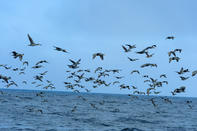Masters of Travel

You would have to be made of strong stuff to tackle a trip like this: Birds have mastered the art of long-haul travel. Since their ancestors first jury-rigged reptilian scales into lightweight instruments of flight, they have defied gravity to cross the planet's most formidable oceans and landmarks. They are an aerodynamic tour de force, which makes a mockery of our feeble attempts at propelling great, lumbering chunks of metal into the sky.
The Arctic tern makes a 32 000 km round trip every year, moving between its breeding grounds in the Arctic and its austral summer stomping grounds in the Antarctic. That's close to a global circumnavigation every year. If a six-seater Cessna were to make a similar trip, it would burn over 5 000 litres of fuel and need to touch down 26 times (every 1 200 km) to fill up.
Blackpoll warbler (Dendroica striata) is so fuel efficient that, if it were an aircraft, it would get the equivalent of over 300 000 km to the litre during its 90-hour trans-ocean marathon dash for the south. A human performing at a similar metabolic rate would have to run the four- minute mile for eighty continuous hours.
Non-stop Flight
Wandering albatrosses are born with itchy feet and are engineered for sailing the westerly winds of the Southern Ocean. A youngster will spend its first seven years on the wing, only coming in to roost on its home island when it's ready to mate. Masterfully crafted by evolution, its wings lock into position, meaning its heart rate is probably lower when it is gliding on the wind than when it 'rests' on water, where it must paddle.
Bar-tailed godwits appear to fly a staggering 13 000 km from Alaska to New Zealand in one mighty leap across the Pacific without a single stop. In mountaineering-speak, 8 000 m above sea level is the start of the death zone. Even sucking on a canister of oxygen, the human body slumps into depression. It becomes physically exhausted, can't catch its breath, feels dizzy and faint, experiences headaches that feel as if the skull will crack open at the temples, and seems unable to heal injuries.
This is no place to harbour an infection. The summit of Mount Everest, the highest point on Earth, reaches up to 8 850 m - that's intruding into the path of high tropospheric jet streams. Even weather patterns find the towering Himalayas impassable. The mid-summer average up there is minus 19°C.
Indicators of Change
Bar-headed geese (Anser indicus) do not see the problem. Every year they pop across the Himalayas on their way from their breeding grounds in Tibet to India and back again. They are regularly seen flying high above the summit of Everest.
These are the supremos of high-altitude migration. And, to date, the highest ever bird strike to an airplane happened at 11.5 km up, when a Rüppell's griffon vulture was sucked into a jet engine above the Ivory Coast of West Africa in 1975. You think that with this phenomenal amount of mobility, birds would be less likely to succumb to the rigours of a changing climate.
Plants cannot uproot and move - if they want to shift their range in response to climate change, they die out on the inhospitable side and slowly sow their seeds on the conformable side, allowing subsequent generations to carry on the legacy as they track climate and physically shift their range.
Terrestrial animals, unless caught up against a geographical barrier, can move more easily, particularly if they have corridors of favourable habitat. Birds, surely, could hop on the next connecting flight and find somewhere else to live. In theory, that's true. But birds have elbowed their way towards the apex of the food chain, so any changes further down the ladder will manifest quickly in their communities. That's why they are a good indicator of change.
Timing is critical for migratory birds: for millennia they have responded to cues from nature, linking their breeding to the peak time of their food sources, whose habits in turn are shaped by cues of their own. Those birds which receive at least part of their migration prompt from ambient temperature are already responding by migrating earlier in a warmer world. While some birds do not appear to have changed their migration time at all, others definitely have.